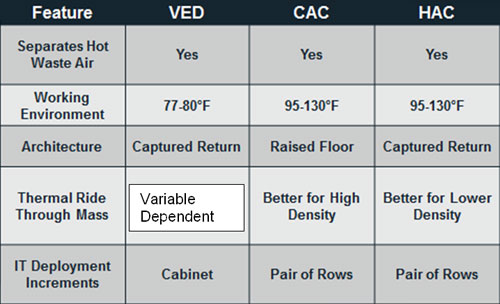Passive Cooling in Data Centers
The VED hot air containment model also essentially eliminates the regular activity of monitoring hot spots and making adjustments to the room to balance cool air distribution. Hence, the above demonstrates that containment acquisition costs, plus construction costs, plus operating costs, combine for a total lower cost of ownership for high-density passive air cooling solutions over alternative solutions for high-density cooling.
Overall then, these three common myths simply don’t hold up. The VED passive cooling solution effectively cools heat loads well in excess of 30 kW per cabinet, while reducing energy costs and the resultant carbon footprint of a data center. The basic principle behind this passive cooling solution is to use the equipment cabinet not as a box for housing computer servers, but rather as an architectural feature of the data center that secures the isolation between the chilled supply air and the heated return air. In addition, the basic misconceptions described come from traditional thinking about liquid cooling systems, while the analysis shown reveals the superior uptime reliability of this cooling approach over any other means of cooling high-density data center heat.
Conclusion
Effectively and efficiently cooling computer rooms and data centers requires a collaborative design process to find the right balance between density of computer equipment, square footage, cooling system equipment, and cooling strategies. Of the strategies presented, the greatest cooling and space efficiency is achieved when the computer server cabinet becomes a central feature of the data center. By using the vertical exhaust duct (VED) approach strategy, the isolation between the supply air and the return air is secured and the cabinet is free from its dependence on specific perforated or grated floor tiles to cool its heat load. Passive cooling solutions have performed adequately in active data centers up to 32 kW per cabinet and have been tested successfully up to 45 kW. This performance level is achieved through the application of sound, but relatively elementary physics principles. Not only does this solution set provide a viable option for cooling higher densities, but it removes any uncertainties associated with potential points of failure, and provides the basis for being able to take advantage of significant energy savings associated with higher HVAC efficiencies and access to greater economizer hours.
 |
A comparison of the three common hot air isolation strategies reveals that the Vertical Exhaust Duct (VED) method is often the superior performing system, particularly for high density applications. Chart courtesy of Chatsworth Products, Inc. |
 |
Chatsworth Products, Inc. (CPI) is a global manufacturer providing voice, data and security products and service solutions that optimize, store and secure technology equipment. CPI Products offer innovation, configurability, quality and value with a breadth of system components, covering virtually all physical layer needs. www.chatsworth.com |








